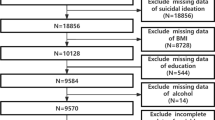Abstract
The purpose of this community-based study was to assess the prevalence of chronic diseases among 18–65 year old Bhutanese refugee women resettled in Northeast Ohio, United States (US). A Nepali-language questionnaire was administered in a face-to-face mode. Anthropometric measurements included height, weight, and hip and waist circumferences. The overall prevalence (95 % confidence interval) of self-reported hypertension, diabetes, asthma, heart disease, and cancer were 15.3 % (9.2–23.4), 6.4 % (2.3–10.9), 5.5 % (2.0–11.5), 2.7 % (0.6–7.8), and 1.8 % (0.2–6.4), respectively. Overweight/obesity was observed in 64.8 % of the women; 69.5 and 74.1 % had waist circumference >80 cm and waist-to-hip ratio ≥85, respectively. Length of time in the US was not associated with the prevalence of the chronic conditions. This study suggests chronic conditions may be significant health issues among US resettled Bhutanese refugees and a larger population-based study to confirm the findings is warranted.
Similar content being viewed by others
References
Martin DC, Yankay JE. Annual flow report. Refugees and asylees: 2011. www.dhs.gov/xlibrary/assets/statistics/publications/ois_rfa_fr_2011.pdf. Accessed March 13, 2014.
Martin DC, Yankay JE. Annual flow report. Refugees and Asylees: 2012. www.dhs.gov/sites/default/files/publications/ois_rfa_fr_2012.pdf. Accessed March 13, 2014.
Centers for Disease Control and Prevention. Bhutanese refugee health profile. www.cdc.gov/immigrantrefugeehealth/pdf/bhutanese-health-profile.pdf. Accessed March 13, 2014.
United Nations High Commissioner for Refugees. 2013 UNHCR country operations profile—Nepal. http://www.unhcr.org/cgi-bin/texis/vtx/page?page=49e487856&submit=GO. Accessed March 13, 2014.
Clinton-Davis L, Fassil Y. Health and social problems of refugees. Soc Sci Med. 1992;35(4):507–51.
Barnett ED. Infectious disease screening for refugees resettled in the United States. Clin Infect Dis. 2004;39(6):833–41.
Centers for Disease Control and Prevention. Vitamin B12 deficiency in resettled Bhutanese Refugees—United States, 2008–2011. MMWR Morb Mortal Wkly Rep. 2011;60(11):343–6.
Marshall GN, et al. Mental health of Cambodian refugees 2 decades after resettlement in the United States. JAMA. 2005;294(5):571–9.
Dharod JM, Crook JE, Sady CG. Food insecurity: its relationship to dietary intake and body weight among Somali refugee women in the United States. J Nutr Educ Behav. 2013;45(1):47–53.
Dookeran NM, et al. Chronic disease and its risk factors among refugees and asylees in Massachusetts, 2001–2005. Prev Chronic Dis 2010;7(3):A51. www.cdc.gov/pcd/issues/2010/may/09_0046.htm. Accessed March 13, 2014.
Yun K, et al. High prevalence of chronic non-communicable conditions among adult refugees. J Commun Health. 2012;37(5):1110–8.
Centers for Disease Control and Prevention. Health of resettled Iraqi refugees—San Diego County, California, october 2007–september 2009. MMWR Morb Mortal Wkly Rep. 2010;59(49):1614–8.
Kumar GS, et al. Noninfectious disease among the Bhutanese Refugee population at a United States urban clinic. J Immigr Minor Health 2013 Mar 2. Published online ahead of print. PMID: 23456726.
Pottie K, et al. Evidence-based clinical guidelines for immigrants and refugees. CMAJ. 2011;183:E824–92.
Yusuf S, et al. Global burden of cardiovascular diseases: Part II: variations in cardiovascular disease by specific ethnic groups and geographic regions and prevention strategies. Circulation. 2001;104(23):2855–64.
Mather HM, Chaturvedi N, Fuller JH. Mortality and morbidity from diabetes in South Asians and Europeans: 11-year follow-up of the Southall Diabetes Survey, London, UK. Diabet Med. 1998;15(1):53–9.
Enas EA, et al. Coronary heart disease and its risk factors in first-generation immigrant Asian Indians to the United States of America. Indian Heart J. 1996;48(4):343–53.
Enas EA, Yusuf S, Mehta J. Prevalence of coronary artery disease in Asian Indians. Am J Cardiol. 1992;70:945–9.
Vikram NK, et al. Non-obese (body mass index <25 kg/m2) Asian Indians with normal waist circumference have high cardiovascular risk. Nutrition. 2003;19(6):503–9.
Raji A, et al. Body fat distribution and insulin resistance in healthy Asian Indians and Caucasians. J Clin Endocrinol Metab. 2001;86(11):5366–71.
Chandalia M, et al. Relationship between generalized and upper body obesity to insulin resistance in Asian Indian men. J Clin Endocrinol Metab. 1999;84(7):2329–35.
Centers for Disease Control and Prevention. About BMI for adults. www.cdc.gov/healthyweight/assessing/bmi/adult_bmi/. Accessed March 13, 2014.
WHO Expert Consultation. Appropriate body-mass index for Asian populations and its implications for policy and intervention strategies. Lancet. 2004;363(9403):157–63.
Snehalatha C, Viswanathan V, Ramachandran A. Cutoff values for normal anthropometric variables in Asian Indian adults. Diabetes Care. 2003;26(5):1380–4.
Rush EC, Freitas I, Plank LD. Body size, body composition and fat distribution: comparative analysis of European, Maori, Pacific Island and Asian Indian adults. Br J Nutr. 2009;102(4):632–41.
Gray LJ, et al. Defining obesity cut-off points for migrant South Asians. PLoS One. 2011;6(10):e26464. doi:10.1371/journal.pone.0026464.
WHO. Waist circumference and waist–hip ratio: report of a WHO expert consultation, Geneva, 8–11 December 2008. whqlibdoc.who.int/publications/2011/9789241501491_eng.pdf. Accessed March 13, 2014.
Schiller JS, Lucas JW, Peregoy JA. Summary health statistics for U.S. adults: National Health Interview Survey, 2011. National Center for Health Statistics. Vital Health Stat. 2012;10(256):149–60.
Rand CS, Kuldau JM. The epidemiology of obesity and self-defined weight problem in the general population: gender, race, age, and social class. Int J Eat Disord. 1990;9(3):329–43.
Miller KJ, et al. Comparisons of body image dimensions by race/ethnicity and gender in a university population. Int J Eat Disord. 2000;27(3):310–6.
Brennan M, Biluhka O, Bosmans M. Refugee health in Nepal: joint UNHCR-WHO evaluation of health and health programmes in Bhutanese refugee camps in Nepal. New York: United Nations High Commissioner for Refugees; 2005.
U.S. Census Bureau. American Community Survey. www.census.gov/acs/www/. Accessed March 13, 2014.
Wong EC, et al. The unusually poor physical health status of Cambodian refugees two decades after resettlement. J Immigr Minor Health. 2011;13(5):876–82.
Acknowledgments
This study was funded by the Kent State University Initiative for Clinical and Translational Research. We want to knowledge Ms. Pratiksha Shrestha for her assistance with data collection and Ms. Sabitra Dulal for her invaluable role as a community liaison. We would like to express our gratitude to the Bhutanese women of Northeast Ohio for their participation in the study.
Author information
Authors and Affiliations
Corresponding author
Rights and permissions
About this article
Cite this article
Bhatta, M.P., Shakya, S., Assad, L. et al. Chronic Disease Burden Among Bhutanese Refugee Women Aged 18–65 Years Resettled in Northeast Ohio, United States, 2008–2011. J Immigrant Minority Health 17, 1169–1176 (2015). https://doi.org/10.1007/s10903-014-0040-9
Published:
Issue Date:
DOI: https://doi.org/10.1007/s10903-014-0040-9




